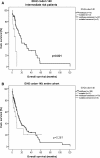Mutations in the isocitrate dehydrogenase 2 gene and IDH1 SNP 105C > T have a prognostic value in acute myeloid leukemia
- PMID: 25324972
- PMCID: PMC4198977
- DOI: 10.1186/2050-7771-2-18
Mutations in the isocitrate dehydrogenase 2 gene and IDH1 SNP 105C > T have a prognostic value in acute myeloid leukemia
Abstract
Background: The isocitrate dehydrogenase (IDH1/IDH2) genes are metabolic enzymes, which are frequently mutated in acute myeloid leukemia (AML). The enzymes acquire neomorphic enzymatic activity when they mutated.
Methods: We have investigated the frequency and outcome of the acquired IDH1/IDH2 mutations and the IDH1 SNP 105C > T (rs11554137) in 189 unselected de novo AML patients by polymerase chain reaction amplification followed by direct sequencing. The survival are presented in Kaplan Meier curves with log rank test. Multivariable survival analysis was conducted using Cox regression method, taking age, risk group, treatment, IDH1/2 mutations and IDH1 SNP105 genotype into account.
Results: Overall, IDH1/2 mutations were found in 41/187 (21.7%) of the AML patients. IDH1 codon 132 mutations were present in 7.9%, whereas IDH2 mutations were more frequent and mutations were identified in codon 140 and 172 in a frequency of 11.1% and 2.6%, respectively. The SNP 105C > T was present in 10.5% of the patients, similar to the normal population. A significantly reduced overall survival (OS) for patients carrying IDH2 codon 140 mutation compared with patients carrying wild-type IDH2 gene (p < 0.001) was observed in the intermediate risk patient group. Neither in the entire patient group nor subdivided in different risk groups, IDH1 mutations had any significance on OS compared to the wild-type IDH1 patients. A significant difference in OS between the heterozygous SNP variant and the homozygous wild-type was observed in the intermediate risk FLT3 negative AML patients (p = 0.004).
Conclusions: Our results indicate that AML-patients with IDH2 mutations or the IDH1 SNP 105C > T variant can represent a new subgroup for risk stratification and may indicate new treatment options.
Keywords: AML; IDH1; IDH2; Prognostic markers; SNP.
Figures



Similar articles
-
Molecular alterations of isocitrate dehydrogenase 1 and 2 (IDH1 and IDH2) metabolic genes and additional genetic mutations in newly diagnosed acute myeloid leukemia patients.J Hematol Oncol. 2012 Mar 7;5:5. doi: 10.1186/1756-8722-5-5. J Hematol Oncol. 2012. PMID: 22397365 Free PMC article.
-
The Synonymous Isocitrate Dehydrogenase 1 315C>T SNP Confers an Adverse Prognosis in Egyptian Adult Patients with NPM1-/CEBPA-Negative Acute Myeloid Leukemia.Indian J Hematol Blood Transfus. 2018 Apr;34(2):240-252. doi: 10.1007/s12288-017-0852-6. Epub 2017 Jul 24. Indian J Hematol Blood Transfus. 2018. PMID: 29622865 Free PMC article.
-
Impact of IDH1 R132 mutations and an IDH1 single nucleotide polymorphism in cytogenetically normal acute myeloid leukemia: SNP rs11554137 is an adverse prognostic factor.J Clin Oncol. 2010 May 10;28(14):2356-64. doi: 10.1200/JCO.2009.27.6899. Epub 2010 Apr 5. J Clin Oncol. 2010. PMID: 20368538
-
IDH1/IDH2 Inhibition in Acute Myeloid Leukemia.Front Oncol. 2021 Mar 29;11:639387. doi: 10.3389/fonc.2021.639387. eCollection 2021. Front Oncol. 2021. PMID: 33898313 Free PMC article. Review.
-
Mechanisms of Resistance to Small Molecules in Acute Myeloid Leukemia.Cancers (Basel). 2023 Sep 15;15(18):4573. doi: 10.3390/cancers15184573. Cancers (Basel). 2023. PMID: 37760544 Free PMC article. Review.
Cited by
-
Impact of IDH1 and IDH2 mutational subgroups in AML patients after allogeneic stem cell transplantation.J Hematol Oncol. 2022 Sep 5;15(1):126. doi: 10.1186/s13045-022-01339-8. J Hematol Oncol. 2022. PMID: 36064577 Free PMC article.
-
Evolving Treatment Strategies for Elderly Leukemia Patients with IDH Mutations.Cancers (Basel). 2018 Jun 6;10(6):187. doi: 10.3390/cancers10060187. Cancers (Basel). 2018. PMID: 29882807 Free PMC article. Review.
-
Distinct and opposite effects of leukemogenic Idh and Tet2 mutations in hematopoietic stem and progenitor cells.Proc Natl Acad Sci U S A. 2023 Jan 24;120(4):e2208176120. doi: 10.1073/pnas.2208176120. Epub 2023 Jan 18. Proc Natl Acad Sci U S A. 2023. PMID: 36652477 Free PMC article.
-
High-throughput screening of the Saccharomyces cerevisiae genome for 2-amino-3-methylimidazo [4,5-f] quinoline resistance identifies colon cancer-associated genes.G3 (Bethesda). 2023 Dec 6;13(12):jkad219. doi: 10.1093/g3journal/jkad219. G3 (Bethesda). 2023. PMID: 37738679 Free PMC article.
-
Association between TERT promoter polymorphisms and acute myeloid leukemia risk and prognosis.Oncotarget. 2015 Sep 22;6(28):25109-20. doi: 10.18632/oncotarget.4668. Oncotarget. 2015. PMID: 26298771 Free PMC article.
References
-
- Grimwade D, Walker H, Oliver F, Wheatley K, Harrison C, Harrison G, Rees J, Hann I, Stevens R, Burnett A, Goldstone A. The importance of diagnostic cytogenetics on outcome in AML: analysis of 1,612 patients entered into the MRC AML 10 trial. The Medical Research Council Adult and Children’s Leukaemia Working Parties. Blood. 1998;92:2322–2333. - PubMed
-
- Grimwade D, Walker H, Harrison G, Oliver F, Chatters S, Harrison CJ, Wheatley K, Burnett AK, Goldstone AH. The predictive value of hierarchical cytogenetic classification in older adults with acute myeloid leukemia (AML): analysis of 1065 patients entered into the United Kingdom Medical Research Council AML11 trial. Blood. 2001;98:1312–1320. doi: 10.1182/blood.V98.5.1312. - DOI - PubMed
-
- Falini B, Mecucci C, Tiacci E, Alcalay M, Rosati R, Pasqualucci L, La Starza R, Diverio D, Colombo E, Santucci A, Bigerna B, Pacini R, Pucciarini A, Liso A, Vignetti M, Fazi P, Meani N, Pettirossi V, Saglio G, Mandelli F, Lo-Coco F, Pelicci PG, Martelli MF. Cytoplasmic nucleophosmin in acute myelogenous leukemia with a normal karyotype. N Engl J Med. 2005;352:254–266. doi: 10.1056/NEJMoa041974. - DOI - PubMed
LinkOut - more resources
Full Text Sources
Other Literature Sources
Miscellaneous

